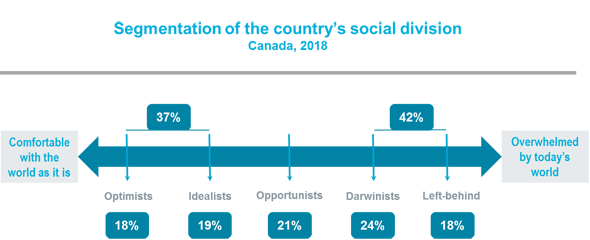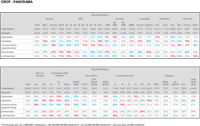It will probably seem obvious to anyone who reads my columns, even occasionally, that one of my constant concerns is the ability of society and individuals to live with the changes that our current era inflicts upon us. Most of the indicators we use to measure the values and mentalities of the consumers and citizens in our country indicate that there is a widening rift in society between those who consider our present era a source of opportunity for personal growth and those who believe that they are living in a cruel social jungle where more and more people are being left behind.
While much of our work has pointed to this sad trend, we have only recently become aware of its full extent through a process of synthesis.
We performed this synthesis for a study on the social division in the country on behalf of Louis Audet, Executive Chairman of COGECO's board of directors. Our study became the topic of his speech to the Montreal Council on Foreign Relations (CORIM ) on October 17.
The goal of this study was to combine all the indicators of values and worldviews that underlie the current social division in order to provide an overall perspective on the issue. We grouped the country's citizens into large groups ("segments") based on their personal values, their view of life today, the opportunities they see there and their attitude toward change.
The country is clearly divided into five large "families" - groups with attitudes, values and worldviews that are radically different from one other. As the graph below illustrates, these "segments" line up perfectly on an "axis" that extends from feeling comfortable with the present world to feeling overwhelmed by it.

From optimism about the era's possibilities to feelings of exclusion!
Whereas in the past society tended to be differentiated primarily along income or generational lines, today, personal values and mentalities are infinitely more important social-demarcation factors. Most of the consumer brands and products we study are differentiated primarily on consumer values rather than on socio-demographic characteristics (even if the particularities of Millennials are attracting a lot of attention at the moment).
These five large segments divide society into almost equal parts, from the Optimists to the Left-behind, which demonstrates the high degree of social division in the Canadian population. This division extends from a vision of today's world as a lever of fulfilment due to its exciting possibilities to a view of the world as pre-apocalyptic and deeply threatening.
Technological and social change are at the heart of this division. Innovation, ethnic and gender diversity, gender identity, gender equality, globalization, increased competitiveness and the financialization of the economy are seen by some as stepping-stones to self-actualization and freedom and by others as threats, even perversions.
Moreover, all these "factors" are at work simultaneously and, as such, are transforming society at a pace unique in the history of mankind. From prehistory to Antiquity, to the Middle Ages and the Industrial Age, history has been speeding up, but never at the exponential rate we are witnessing now.
Technological innovation continues to escalate and its pace will only accelerate. The migration of people, already an important factor, will become even more acute. Individual freedom is front and centre, giving free rein to all forms of personal expression and lifestyles far beyond traditional norms.
But it is people's worldview, their attitude toward this whirlwind, that most divides and segments the population today; and that is causing all the social and political upheavals that we are experiencing. Income and education are important factors in feeding this division but they do not account for everything. Our personal values, those inherited from our cultural heritage and from previous generations, which we have adopted over the years and on which we fall back on over time, and the vision and energy with which we approach life are infinitely more determinant.
Five segments of Canadians, five different mentalities
These five major families of citizens, for which there is no significant regional variation in the country, can be summarized as follows ...
Optimists (18%):
A unique connection to their individual potential, a strong sense of control over their lives, great enthusiasm for technological and social change, a strong ability to navigate through uncertainty, very respectful of differences and the environment: life today is a great source of excitement and opportunity for them (a higher percentage of people with higher incomes and education, and people 55 and older);
Idealists (19%):
They aspire to a society of sharing and respect, while still being very concerned about the future of the planet and their own financial future. Their worldview is apocalyptic and ecologically alarmist, leading them to reject corporations and our capitalist society (a higher percentage of young people under 35, women, office workers and low-income individuals);
Opportunists (21%):
People very focused on success, but who feel potentially excluded and disoriented and who are willing to do anything to win or regain an enviable social status; a large capacity for adaptation combined with a high degree of social conservatism; strong ethnic intolerance, even though there are many immigrants among their ranks (a higher percentage people aged 25 to 44 and ethnic communities - they are intolerant of ethnic communities except their own!);
Darwinists (24%):
Individuals haunted by a very Darwinist view of today's society, comparing it to a ruthless jungle from which anyone can be ejected at any moment; they believe that the only way to adapt to it, individually and socially, is to return to very conservative values in which roles (male/female, in particular) are very well defined and determined by tradition (a higher percentage of men, people aged 45 and up and high-income individuals);
Left-behind (18%):
People very anxious about their financial prospects; they feel socially excluded, fail to set goals and put the blame on the elites, immigrants and the new social models (a higher percentage of people aged 45 and up , low income and educational levels, as well as people living in the regions).
When pessimism and conservatism prevail over optimism and sociocultural modernity!
Optimists and Idealists combined total 37% of the population, compared with 42% for Darwinists and the Left-behind. The former are driven by projects and thrive on change, while the latter fight to maintain their position in a world in turmoil. Opportunists are a hybrid, fearful of exclusion while expending their energy in madly climbing the traditional social ladder.
The transformations in society and the economy do not offer the same opportunities to everyone. The dream of self-actualization is shared in a very unequal way. As we have seen, income and education partly explain this divergence (Idealists have low incomes, while Darwinists have high incomes) but not entirely. Fuelling this division is a growing cynicism toward elites and a view that future prospects are blocked.
The question is: In what direction will this dynamic evolve? If waves of innovation powered by artificial intelligence erase more jobs than they create, cynicism could continue to grow along with sharper social divisions. However, let's stay optimistic.
In the meantime, this social divide could pose a real threat to our democracy. Feelings of exclusion and cynicism pave the way for populism and demagogic leaders who exploit these feelings. Our institutions need a minimum of social cohesion and commitment to function properly. Without them, the future does not bode well.
Nevertheless, Canada has a relatively healthy social, civic and democratic life compared to many other countries in the world. Let's hope that we can maintain this somewhat fragile cohesion.
